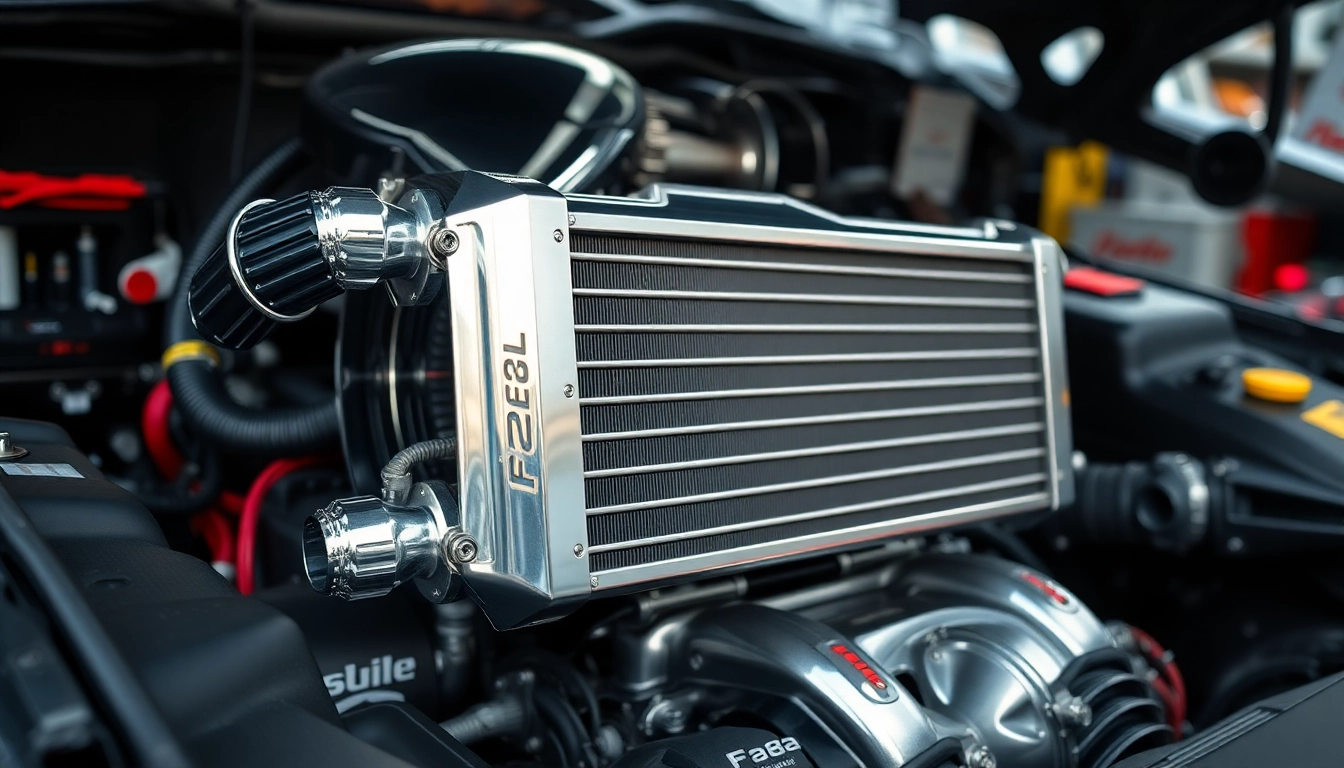Understanding the Importance of the F82 Intercooler
In the world of high-performance automotive engineering, the f82 intercooler stands as a critical component, particularly within the BMW F82 model series, which includes the M4 and M3. This article delves into the core functionalities of the intercooler, its impact on engine performance, common issues associated with original equipment manufacturer (OEM) models, and how a systematic upgrade can lead to significant benefits.
Basic Functionality of an Intercooler
At its core, the intercooler serves one primary purpose: reducing the temperature of the intake air before it enters the engine. When air is compressed, as during the turbocharging process, its temperature increases. This hot air is less dense, containing fewer oxygen molecules per volume, which is detrimental to combustion efficiency. An intercooler allows this compressed air to cool down, thereby increasing its density and oxygen content. The enhanced charge air results in better fuel combustion, which can lead to improved engine performance and efficiency.
Impact on Engine Performance
The benefits of an efficient intercooler go beyond mere cooling. By decreasing the temperature of the intake charge, an upgraded intercooler can lead to:
- Increased Power Output: Cooler air allows for a more complete combustion process, leading to higher horsepower and torque.
- Improved Throttle Response: More oxygen in the intake charge allows for quicker engine response.
- Enhanced Fuel Efficiency: Efficient combustion reduces the amount of fuel required to produce the same power, improving overall efficiency.
Common Issues with OEM Intercoolers
Many factory-installed intercoolers tend to be made from plastic and often come with design limitations that can impede performance. Common problems with OEM intercoolers include:
- Heat Soak: During extended periods of high-load driving, the intercooler can reach a temperature limit beyond which it fails to adequately cool the intake air.
- Material Limitations: Plastic intercoolers can become brittle over time, leading to leaks and reduced efficiency.
- Size Constraints: OEM intercoolers may not be optimized for cars that have been tuned for higher power outputs, which can lead to inadequate cooling under these conditions.
Choosing the Right F82 Intercooler
Selecting the appropriate intercooler for your F82 is essential to maximize performance outputs. Considerations include material composition, size, design variations, and compatibility with other engine modifications.
Material Considerations: Plastic vs. Metal
One of the first decisions when choosing an intercooler is between plastic and metal. While plastic intercoolers are often less expensive, they lack the durability and heat dissipation properties of metal units. Aluminum, for instance, offers higher thermal conductivity, allowing for more efficient cooling. Moreover, metal intercoolers tend to withstand the rigors of higher performance more effectively, making them a better long-term investment.
Size and Design Variations
Intercoolers come in various sizes and designs, including top mount, front mount, and air-to-water systems. The choice between these options will largely depend on the specific performance goals and existing modifications on your vehicle. A larger core size typically means a greater surface area for heat dissipation and improved efficiency. However, it’s crucial to strike a balance to avoid excessive air flow restrictions that can hinder engine performance.
Compatibility with Other Engine Modifications
When upgrading to an aftermarket intercooler, it’s essential to ensure compatibility with existing and planned performance modifications. Components such as turbos, intake systems, and exhaust systems should all work in conjunction to achieve optimal engine performance. This means verifying that the intercooler can support increased airflow demands and doesn’t create bottlenecks in the system.
Installation Steps for the F82 Intercooler
Once you’ve chosen the right intercooler for your BMW F82, the next step is installation. While an experienced mechanic can perform this task, many enthusiasts choose to tackle it themselves. Below are essential considerations and steps for the installation process.
Tools Required for the Installation
Before embarking on the installation, gather the following tools:
- Socket Wrench Set
- Screwdrivers (Flathead and Phillips)
- Pliers
- Torque Wrench
- New Gaskets or Seals (if needed)
- Hose Clamps (if applicable)
- Heat-Resistant Gloves
Step-by-Step Installation Guide
- Preparation: Disconnect the battery and relieve any pressure from the cooling system.
- Remove Original Intercooler: Detach all hoses and mounting hardware securing the OEM intercooler. Carefully lift it out of the engine bay.
- Install New Intercooler: Position the new intercooler in place. Ensure that the mounting points align correctly and that all inlet and outlet pipes are fitted securely.
- Reconnect Hoses: Reattach all hoses and ensure that they are properly secured with hose clamps.
- Final Checks: Go over all connections and fasteners to ensure everything is tight, then reconnect the battery.
- Test Drive: Start the engine and monitor for any leaks. A short test drive will validate that the installation was successful.
Common Mistakes to Avoid
During installation, several common pitfalls may arise, leading to performance issues:
- Neglecting Gaskets: Always replace gaskets when installing a new intercooler.
- Cross-Threading Bolts: Avoid forcing fasteners; ensure they thread smoothly to prevent damage.
- Ignoring Electrical Connections: Be cautious when disconnecting sensors and other electrical components. Ensuring they are reconnected properly is critical.
Performance Gains from Upgrading the F82 Intercooler
One of the primary reasons to consider upgrading the intercooler is the substantial performance gains it offers. With the right intercooler, you can expect improved charge air cooling, enhanced horsepower production, and tangible real-world performance metrics.
Improved Charge Air Cooling
As previously mentioned, the fundamental role of an intercooler is to cool the charge air before it enters the engine. Cooler charge air translates into higher density and increased oxygen supply. This results in a more efficient combustion process, ultimately leading to greater power output.
Enhanced Horsepower Production
Many drivers report significant gains in horsepower after upgrading their intercooler. With cooler air being channeled into the engine, the increase in oxygen density often results in a more powerful combustion cycle. This translates directly into enhanced throttle response and overall driving fun.
Real-World Performance Metrics
Performance metrics can vary depending on the specific model and modifications, but many enthusiasts have recorded power gains in the range of 20 to 60 additional horsepower post-installation of an upgraded intercooler. This performance boost, combined with optimized engine efficiency, creates a noticeable difference in driving dynamics, especially during spirited driving or competitive scenarios.
Maintaining Your F82 Intercooler for Longevity
Once you have installed your f82 intercooler, proper maintenance will ensure its longevity and performance. Regular inspections and care can prevent significant issues down the line.
Routine Inspection and Maintenance
Periodically check for signs of wear or damage to the intercooler, as well as any associated hoses and connections. Look for cracks, dents, or signs of leaks, which can drastically reduce the effectiveness of your intercooler. A maintenance schedule that includes visual inspections and cleaning will help preserve functionality.
Identifying Leaks and Failures
Leakage in an intercooler can drastically affect engine performance. Signs of leaks may include reduced throttle response, engine overheating, or audible hissing sounds while the engine is under load. If suspected, perform pressure tests to check for leaks effectively.
Tips for Optimal Performance Throughout Its Lifespan
To maintain optimal performance from your intercooler, consider the following tips:
- Keep it Clean: Regularly clean the exterior of the intercooler to prevent dirt and debris from interfering with airflow.
- Check Mounting Securely: Ensure that the intercooler remains securely mounted to avoid rattling or damage while driving.
- Regular Service: Incorporate intercooler checks into your vehicle’s service schedule, especially if you regularly drive in extreme conditions.
In conclusion, investing in a high-quality f82 intercooler is a crucial step for any enthusiast looking to enhance their BMW’s performance. Through proper selection, installation, maintenance, and awareness of performance metrics, drivers can enjoy the full benefits of their vehicle’s upgraded capabilities.



